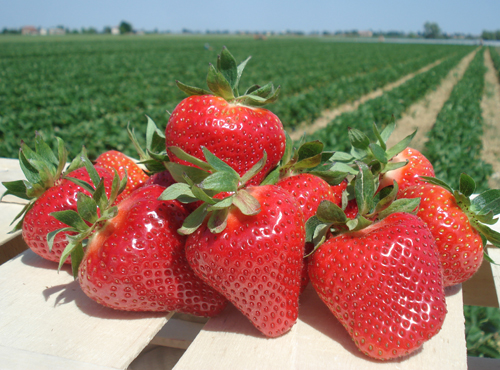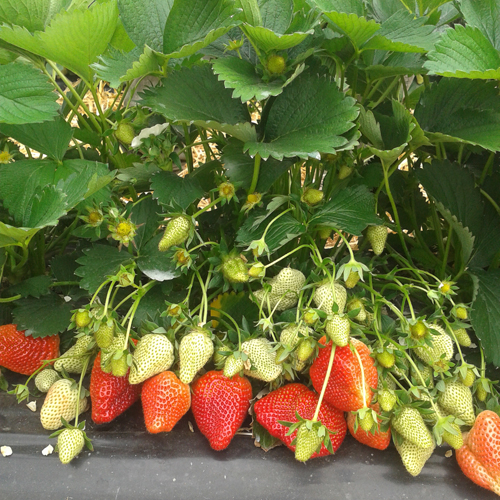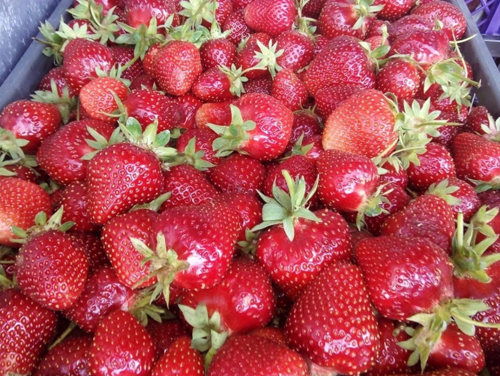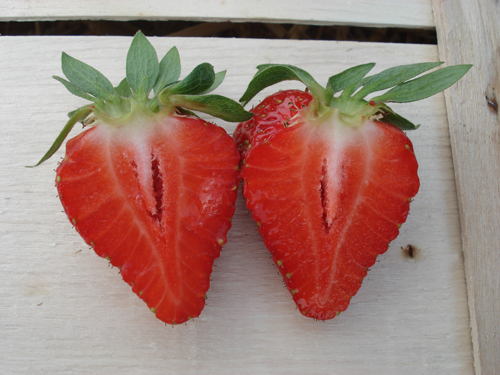Jolie strawberry variety
Jolie is a non-repairable variety of garden strawberries (strawberries) with a medium early ripening period. Bred in Italy by the specialists of the consortium of Italian nurseries (CIV) in 2004, from 2005 to 2010 the variety was tested on various plantations in Europe. Despite her rather young age, this Italian has already managed to win a large number of positive reviews about herself. The variety belongs to the rank of commercial, therefore it is famous for its beautiful uniform berries and good yield, and, coupled with excellent dessert taste, strawberries become attractive not only for farmers, but also for ordinary summer residents. Particularly noteworthy is the possibility of growing Jolie in a variety of climatic conditions and on different types of soil.

The plant is tall, powerful, erect, spreading. The education is very abundant. The leaves are large, medium-wrinkled, smooth, bright green in color. The flowers are bisexual, white. The plant forms a lot of peduncles, they are long, thick, with weak pubescence, are located at the level of the leaves, and lie on the ground under the weight of the harvest.
Jolie has berries of medium and large sizes, regular conical shape, with a short neck or without it at all. The fruit is uniform in size and shape, as well as a high percentage of first-class berries. The skin of the fruit is bright red with a glossy sheen. Achenes are small, yellow, shallowly depressed, almost superficially. The berry, as it ripens, is colored gradually, unripe fruits have an unpainted tip, but even at this stage they have excellent taste. The flesh of strawberries is red, rather dense, but not firm, without crunch when biting, juicy, with a delicate moderately pronounced aroma. The fruits do not form voids even with a lack of moisture in the soil.

The taste of the variety is very sweet, but not without acidity, which subtly emphasizes the sweetness, diluting the flavor palette, making it multifaceted and spontaneous. Jolie berries perfectly tolerate transportation and are perfectly stored even without refrigeration units, making them suitable for long-distance transportation. Strawberries are versatile in use, especially good fresh, suitable for processing and freezing. It is worth saying that the variety was purposefully bred for use in order to sell fresh products to the market, and it really fully justifies this purpose, more than adding to itself honor with excellent taste.
Jolie's berries are not gigantic, but very large - the average weight per season is 20-30 grams. At the first harvest, the fruits are larger, they can reach 40 grams, by the end of fruiting they are only slightly smaller, but not to the state of frank trifles. The yield of our heroine is quite decent, but you cannot call it high at the present time, given the plentiful assortment of high-yielding varieties on the market. The average is 700-850 grams per plant. In general, since the variety is commercial, the yield is highly dependent on the intensity of agricultural technology. But, according to reviews of summer residents and data from various sources, the potential of this strawberry is quite modest, in which it is significantly inferior to its competitors in the market. Actually, to be honest, her yield is really average, or to be more precise, slightly above average. But, as gardeners say, the taste completely covers this nuance.

Ripening begins in the middle or mid-early period, depending on the climatic conditions of the region and agricultural technology. On average, Jolie ripens about 3-5 days later. Clery... Fruiting in our heroine is quite extended, while very stable. By the way, when grown under shelters or in greenhouses, the Italian can even catch up with the early varieties in terms of ripening.
The variety is quite resistant to various diseases of the root system and foliage, but high-quality prevention will clearly not be superfluous.A “commercial” grade of strawberries automatically implies the need for regular treatments against disease and pests if you want to get the most out of your plants. If such a goal is not worth it, then, in principle, you can use folk remedies, Jolie feels pretty good even without "chemistry".

The plant has good winter hardiness, but with strong temperature changes and a small amount of snow, it can be seriously damaged, so you should take care of a good shelter. In general, our Italian heroine is zoned for a mild climate, and although she adapts very well to an unfamiliar environment, it is still worth protecting her from the harmful effects of extreme weather conditions. But with the drought resistance of the variety, everything is fine - in the driest seasons it will not let you down. Of course, do not neglect watering so that the harvest does not disappoint you. By the way, gardeners note that strawberries are always sweet, despite various weather adversities.
Our heroine is undemanding to soils, she can grow on a variety of soils, but it is necessary that the land be fertile. Before planting, organic and mineral fertilizers are introduced into the soil without fail. There are no outstanding features in the agricultural technology of Jolie cultivation, therefore, we will only mention the most basic points that should be paid attention to.
- Planting is carried out according to the standard scheme - a distance of 25-30 cm should be maintained between the bushes, no more than 5 plants are planted per 1 square meter. If possible, you can plant more space, in which case the yield of strawberries may increase, and the risk of diseases may decrease.
- It is imperative to provide the plant with good nutrition. A commercial variety requires abundant fertilization if impressive yields are to be achieved. But if you forget about the numbers and benefits, one thing can be noted - with insufficient nutrition, the likelihood of chlorosis is high. In a word, do not forget about feeding, no matter what growing goals you pursue.
- Rejuvenate the plantation in a timely manner, the optimal period of use with moderate agricultural technology is 3-4 years, then the yield is significantly reduced. With intensive technology, it is advisable to grow strawberries in a one-year culture, maximum two-year.
Let's summarize a little. Jolie is a very good specimen, capable of delighting both in yield and taste. It is recommended for small to medium volume commercial use as well as for hobbyist growers. We will not re-enumerate all the advantages of our heroine, but let's talk about the shortcomings. The most important nuance is insufficient yield, which does not allow the variety to break into the list of market favorites. And, to be honest, there are a lot of alternatives - Jolie is not so outstanding as to strongly recommend her for growing. On the other hand, everyone has different tastes and preferences, so for some this Italian woman can become a favorite. In short, try to grow yourself, and then draw conclusions. But this strawberry definitely cannot be called bad, according to its characteristics it is quite good for itself, and maybe in the near future it will show everyone how great it is.








